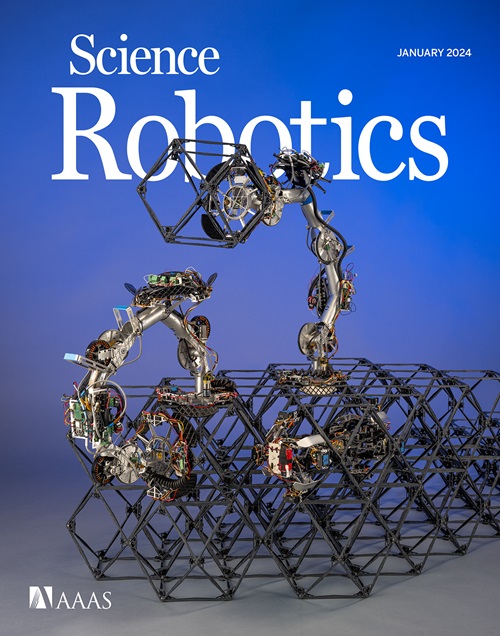生物启发设计的组织工程射线与机器学习
IF 27.5
1区 计算机科学
Q1 ROBOTICS
引用次数: 0
摘要
在仿生设计中,研究人员重建现有的生物结构来形成功能装置。对于组织工程组装的生物混合机器人游泳者来说,这是一个问题,因为大多数设备的运行长度与自然发生的设备不同,导致性能下降。为了克服这些挑战,在这里,我们展示了如何使用机器学习定向优化(ML-DO)来为生物混合机器人的设计提供信息,在高性能几何形状的选择上优于其他非线性优化技术,如贝叶斯优化。我们展示了这种方法如何被用来最大限度地提高由组织工程变形微型机器人产生的推力。这使得设备可以在毫米尺度上游泳,同时更紧密地保持自然的机车缩放定律。总的来说,这项工作为自动化方式的肌肉结构-功能关系的工程设计提供了定量严格的方法。本文章由计算机程序翻译,如有差异,请以英文原文为准。
Bioinspired design of a tissue-engineered ray with machine learning
In biomimetic design, researchers recreate existing biological structures to form functional devices. For biohybrid robotic swimmers assembled with tissue engineering, this is problematic because most devices operate at different length scales than their naturally occurring counterparts, resulting in reduced performance. To overcome these challenges, here, we demonstrate how machine learning–directed optimization (ML-DO) can be used to inform the design of a biohybrid robot, outperforming other nonlinear optimization techniques, such as Bayesian optimization, in the selection of high-performance geometries. We show how this approach can be used to maximize the thrust generated by a tissue-engineered mobuliform miniray. This results in devices that can swim at the millimeter scale while more closely preserving natural locomotive scaling laws. Overall, this work provides a quantitatively rigorous approach for the engineering design of muscular structure-function relationships in an automated fashion.
求助全文
通过发布文献求助,成功后即可免费获取论文全文。
去求助
来源期刊

Science Robotics
Mathematics-Control and Optimization
CiteScore
30.60
自引率
2.80%
发文量
83
期刊介绍:
Science Robotics publishes original, peer-reviewed, science- or engineering-based research articles that advance the field of robotics. The journal also features editor-commissioned Reviews. An international team of academic editors holds Science Robotics articles to the same high-quality standard that is the hallmark of the Science family of journals.
Sub-topics include: actuators, advanced materials, artificial Intelligence, autonomous vehicles, bio-inspired design, exoskeletons, fabrication, field robotics, human-robot interaction, humanoids, industrial robotics, kinematics, machine learning, material science, medical technology, motion planning and control, micro- and nano-robotics, multi-robot control, sensors, service robotics, social and ethical issues, soft robotics, and space, planetary and undersea exploration.
 求助内容:
求助内容: 应助结果提醒方式:
应助结果提醒方式:


